Enhancing Storm Wave Predictions in the Gulf of Mexico: A Study on Wind Drag Parameterization in WAVEWATCH III
Abstract
1. Introduction
2. Hurricane Ida Description
3. Data and Methodology
3.1. Atmospheric Forcing
3.1.1. HRRR—High-Resolution Rapid Refresh
3.1.2. ECMWF—High-Resolution Operational Forecast Model
3.2. WAVEWATCH III Configuration
3.3. Wind Drag Methods
4. Results and Discussion
5. Summary and Conclusions
- HRRR well represented the wind speeds at buoys 42003, 42012, and 42040, where the maximum wind speeds in these locations were observed to be around 25 m/s. At the BURL1 station (closest to Ida’s track), the model underestimated the peak hurricane wind speeds by 14%. The spatial representation of the hurricane wind bands was well captured by HRRR as Hurricane Ida made landfall along the Louisiana coastline.
- The significant wave heights computed for cases ST4, ST6, and ST6-IWD were compared with in situ observations. It was noticed that the standard ST4 scheme did not perform well under hurricane wind conditions and tended to underestimate the peak wave heights generated by Hurricane Ida, while the ST6 and ST6-IWD schemes performed well for extreme wind conditions. The percentage error ranges computed for all three cases were as follows: ST4: −4.47% to 15.71%, ST6: −1% to 14.29%, and ST6-IWD: 0.97% to 10% (negative % indicates underestimation and positive % indicates overestimation). From the error range metrics and statistical indicators, it can be seen that the ST6-IWD method performed better than ST4 and ST6 in terms of peak wave height estimation. The main advantage of ST6-IWD over ST6 is that the wind input source term requires a cut-off function only beyond ~113 m/s, whereas the latter needs it after 50 m/s wind speeds.
- The peak wave periods and peak wave directions also emphasized that the ST6-IWD-based estimations were better than the those of the ST4 and ST6 schemes. This was further confirmed through statistical estimates, where ST6 had the highest RMSE compared to ST6-IWD and ST4. Therefore, it is imperative to recommend the ST6-IWD scheme for performing storm wave simulations for the Gulf of Mexico basin. The improved accuracy of the ST6-IWD scheme in capturing peak wave characteristics makes it a valuable tool for predicting storm impacts. Additionally, its ability to handle higher wind speeds without requiring a cut-off function further enhances its reliability for extreme weather conditions.
- Further study is required to conduct a comprehensive analysis of how these schemes perform with different configurations of unstructured grids. Additionally, it is important to investigate how these schemes respond to other hurricanes in the Gulf and cyclones that evolve in various other regions, such as in the northern Indian Ocean and the western Pacific Ocean. This broader analysis will help validate the robustness and adaptability of the ST6-IWD scheme (in WW3) across diverse meteorological conditions and geographical locations.
Author Contributions
Funding
Institutional Review Board Statement
Informed Consent Statement
Data Availability Statement
Acknowledgments
Conflicts of Interest
| 1 | Authors acknowledge that the study area has been recognized as Gulf of America in 2025. During the submission of this manuscript and during the study period of this work for Hurricane Ida in 2021 [1], our study area was recognized as Gulf of Mexico. Therefore, the study area is labeled as Gulf of Mexico throughout this manuscript. |
References
- Beven, J.L.; Hagen, A.; Berg, R. National Hurricane Center Tropical Cyclone Report; NOAA: Silver Spring, MD, USA, 2022; pp. 1–163. [Google Scholar]
- NOAA-NCEI. U.S. Billion-Dollar Weather and Climate Disasters. 2024. Available online: https://www.ncei.noaa.gov/access/billions/ (accessed on 14 December 2024).
- Janssen, P.A.; Viterbo, P. Ocean waves and the atmospheric climate. J. Clim. 1996, 9, 1269–1287. [Google Scholar] [CrossRef]
- Janssen, P.A.E.M.; Doyle, J.D.; Bidlot, J.; Hansen, B.; Isaksen, L.; Viterbo, P. Impact and feedback of ocean waves on the atmosphere. Adv. Fluid Mech. 2002, 33, 155–198. [Google Scholar]
- Wahle, K.; Staneva, J.; Koch, W.; Fenoglio-Marc, L.; Ho-Hagemann, H.; Stanev, E.V. An atmosphere–wave regional coupled model: Improving predictions of wave heights and surface winds in the southern North Sea. Ocean Sci. 2017, 13, 289–301. [Google Scholar] [CrossRef]
- Shankar, C.G.; Cambazoglu, M.K.; Bernstein, D.N.; Hesser, T.J.; Wiggert, J.D. Sensitivity and impact of atmospheric forcings on hurricane wind wave modeling in the Gulf of Mexico using nested WAVEWATCH III. Appl. Ocean Res. 2025, 154, 104320. [Google Scholar] [CrossRef]
- Valiente, N.G.; Saulter, A.; Edwards, J.M.; Lewis, H.W.; Castillo Sanchez, J.M.; Bruciaferri, D.; Bunney, C.; Siddorn, J. The impact of wave model source terms and coupling strategies to rapidly developing waves across the north-west european shelf during extreme events. J. Mar. Sci. Eng. 2021, 9, 403. [Google Scholar] [CrossRef]
- Shankar, C.G.; Behera, M.R. Wave Boundary Layer Model based wind drag estimation for tropical storm surge modelling in the Bay of Bengal. Ocean Eng. 2019, 191, 106509. [Google Scholar] [CrossRef]
- Shankar, C.G.; Behera, M.R. Improved wind drag formulation for numerical storm wave and surge modeling. Dyn. Atmos. Ocean. 2021, 93, 101193. [Google Scholar] [CrossRef]
- Charnock, H. Wind stress on a water surface. Q. J. R. Meteorol. Soc. 1955, 81, 639–640. [Google Scholar] [CrossRef]
- Smith, S.D.; Banke, E.G. Variation of the sea surface drag coefficient with wind speed. Q. J. R. Meteorol. Soc. 1975, 101, 665–673. [Google Scholar] [CrossRef]
- Garratt, J.R. Review of drag coefficients over oceans and continents. Mon. Weather. Rev. 1977, 105, 915–929. [Google Scholar] [CrossRef]
- Large, W.G.; Pond, S. Open ocean momentum flux measurements in moderate to strong winds. J. Phys. Oceanogr. 1981, 11, 324–336. [Google Scholar] [CrossRef]
- Wu, J. Wind-stress coefficients over sea surface from breeze to hurricane. J. Geophys. Res. Ocean. 1982, 87, 9704–9706. [Google Scholar] [CrossRef]
- Guan, C.; Xie, L. On the linear parameterization of drag coefficient over sea surface. J. Phys. Oceanogr. 2004, 34, 2847–2851. [Google Scholar] [CrossRef]
- Gao, Z.; Wang, Q.; Wang, S. An alternative approach to sea surface aerodynamic roughness. J. Geophys. Res. Atmos. 2006, 111, D22108. [Google Scholar] [CrossRef]
- Powell, M.D.; Vickery, P.J.; Reinhold, T.A. Reduced drag coefficient for high wind speeds in tropical cyclones. Nature 2003, 422, 279–283. [Google Scholar] [CrossRef]
- Donelan, M.A.; Haus, B.K.; Reul, N.; Plant, W.J.; Stiassnie, M.; Graber, H.C.; Brown, O.B.; Saltzman, E.S. On the limiting aerodynamic roughness of the ocean in very strong winds. Geophys. Res. Lett. 2004, 31, L18306. [Google Scholar] [CrossRef]
- Jarosz, E.; Mitchell, D.A.; Wang, D.W.; Teague, W.J. Bottom-up determination of air-sea momentum exchange under a major tropical cyclone. Science 2007, 315, 1707–1709. [Google Scholar] [CrossRef]
- Hwang, P.A. A note on the ocean surface roughness spectrum. J. Atmos. Ocean. Technol. 2011, 28, 436–443. [Google Scholar] [CrossRef]
- Holthuijsen, L.H.; Powell, M.D.; Pietrzak, J.D. Wind and waves in extreme hurricanes. J. Geophys. Res. Ocean. 2012, 117, C09003. [Google Scholar] [CrossRef]
- Zijlema, M.; Van Vledder, G.P.; Holthuijsen, L.H. Bottom friction and wind drag for wave models. Coast. Eng. 2012, 65, 19–26. [Google Scholar] [CrossRef]
- Makin, V.K.; Kudryavtsev, V.N. Coupled sea surface-atmosphere model: 1. Wind over waves coupling. J. Geophys. Res. Ocean. 1999, 104, 7613–7623. [Google Scholar] [CrossRef]
- Makin, V.K.; Kudryavtsev, V.N. Impact of dominant waves on sea drag. Bound.-Layer Meteorol. 2002, 103, 83–99. [Google Scholar] [CrossRef]
- Hara, T.; Belcher, S.E. Wind forcing in the equilibrium range of wind-wave spectra. J. Fluid Mech. 2002, 470, 223–245. [Google Scholar] [CrossRef]
- Hara, T.; Belcher, S.E. Wind profile and drag coefficient over mature ocean surface wave spectra. J. Phys. Oceanogr. 2004, 34, 2345–2358. [Google Scholar] [CrossRef]
- Moon, I.J.; Hara, T.; Ginis, I.; Belcher, S.E.; Tolman, H.L. Effect of surface waves on air–sea momentum exchange. Part I: Effect of mature and growing seas. J. Atmos. Sci. 2004, 61, 2321–2333. [Google Scholar] [CrossRef]
- Du, J.; Larsén, X.G.; Chen, S.; Bolaños, R.; Badger, M.; Yang, Y. The impact of wind–wave coupling with WBLM on coastal storm simulations. Ocean Model. 2022, 180, 102135. [Google Scholar] [CrossRef]
- Janssen, P.A.; Bidlot, J.R. Wind–wave interaction for strong winds. J. Phys. Oceanogr. 2023, 53, 779–804. [Google Scholar] [CrossRef]
- Makrygianni, N.; Pan, S.; Bray, M.; Bidlot, J.R. Modelling of hurricane Dorian via the implementation of Wave Boundary Layer Model (WBLM) within the OpenIFS. Ocean Model. 2025, 194, 102469. [Google Scholar] [CrossRef]
- Moon, I.J.; Ginis, I.; Hara, T.; Thomas, B. A physics-based parameterization of air–sea momentum flux at high wind speeds and its impact on hurricane intensity predictions. Mon. Weather Rev. 2007, 135, 2869–2878. [Google Scholar] [CrossRef]
- Reichl, B.G.; Hara, T.; Ginis, I. Sea state dependence of the wind stress over the ocean under hurricane winds. J. Geophys. Res. Ocean. 2014, 119, 30–51. [Google Scholar] [CrossRef]
- Zhao, B.; Wu, L.; Wang, G.; Zhang, J.A.; Liu, L.; Zhao, C.; Zhuang, Z.; Xia, C.; Xue, Y.; Li, X.; et al. A numerical study of tropical cyclone and ocean responses to air-sea momentum flux at high winds. J. Geophys. Res. Ocean. 2024, 129, e2024JC020956. [Google Scholar] [CrossRef]
- Chen, Y.; Yu, X. Enhancement of wind stress evaluation method under storm conditions. Clim. Dyn. 2016, 47, 3833–3843. [Google Scholar] [CrossRef]
- Chen, Y.; Yu, X. Sensitivity of storm wave modeling to wind stress evaluation methods. J. Adv. Model. Earth Syst. 2017, 9, 893–907. [Google Scholar] [CrossRef]
- Shankar, C.G.; Behera, M.R. Numerical analysis on the effect of wave boundary condition in storm wave and surge modeling for a tropical cyclonic condition. Ocean Eng. 2021, 220, 108371. [Google Scholar] [CrossRef]
- Luettich, R.A.; Westerink, J.J.; Scheffner, N.W. ADCIRC: An Advanced Three-Dimensional Circulation Model for Shelves, Coasts, and Estuaries. Report 1. Theory and Methodology of ADCIRC-2DDI and ADCIRC-3DL. 1992. [Google Scholar]
- Booij, N.R.R.C.; Ris, R.C.; Holthuijsen, L.H. A third-generation wave model for coastal regions: 1. Model description and validation. J. Geophys. Res. Ocean. 1999, 104, 7649–7666. [Google Scholar] [CrossRef]
- Tolman, H.L.; Chalikov, D. Source terms in a third-generation wind wave model. J. Phys. Oceanogr. 1996, 26, 2497–2518. [Google Scholar] [CrossRef]
- Hasselmann, K. On the spectral dissipation of ocean waves due to white capping. Bound.-Layer Meteorol. 1974, 6, 107–127. [Google Scholar] [CrossRef]
- Snyder, R.L.; Dobson, F.W.; Elliott, J.A.; Long, R.B. Array measurements of atmospheric pressure fluctuations above surface gravity waves. J. Fluid Mech. 1981, 102, 1–59. [Google Scholar] [CrossRef]
- Komen, G.J.; Hasselmann, S.; Hasselmann, K. On the existence of a fully developed wind-sea spectrum. J. Phys. Oceanogr. 1984, 14, 1271–1285. [Google Scholar] [CrossRef]
- Chalikov, D.V.; Belevich, M.Y. One-dimensional theory of the wave boundary layer. Bound.-Layer Meteorol. 1993, 63, 65–96. [Google Scholar] [CrossRef]
- Chalikov, D. The parameterization of the wave boundary layer. J. Phys. Oceanogr. 1995, 25, 1333–1349. [Google Scholar] [CrossRef]
- Janssen, P. The Interaction of Ocean Waves and Wind; Cambridge University Press: Cambridge, UK, 2004. [Google Scholar]
- Bidlot, J.R.; Abdalla, S.; Janssen, P. A Revised Formulation for Ocean Wave Dissipation in cy25r1; Research Department, ECMWF: Reading, UK, 2005. [Google Scholar]
- Ardhuin, F.; Rogers, E.; Babanin, A.V.; Filipot, J.F.; Magne, R.; Roland, A.; Van Der Westhuysen, A.; Queffeulou, P.; Lefevre, J.M.; Aouf, L.; et al. Semiempirical dissipation source functions for ocean waves. Part I: Definition, calibration, and validation. J. Phys. Oceanogr. 2010, 40, 1917–1941. [Google Scholar] [CrossRef]
- Zieger, S.; Babanin, A.V.; Rogers, W.E.; Young, I.R. Observation-based source terms in the third-generation wave model WAVEWATCH. Ocean Model. 2015, 96, 2–25. [Google Scholar] [CrossRef]
- Liu, Q.; Rogers, W.E.; Babanin, A.V.; Young, I.R.; Romero, L.; Zieger, S.; Qiao, F.; Guan, C. Observation-based source terms in the third-generation wave model WAVEWATCH III: Updates and verification. J. Phys. Oceanogr. 2019, 49, 489–517. [Google Scholar] [CrossRef]
- Umesh, P.A.; Behera, M.R. Performance evaluation of input-dissipation parameterizations in WAVEWATCH III and comparison of wave hindcast with nested WAVEWATCH III-SWAN in the Indian Seas. Ocean Eng. 2020, 202, 106959. [Google Scholar] [CrossRef]
- van Vledder, G.P.; Hulst, S.T.C.; McConochie, J.D. Source term balance in a severe storm in the Southern North Sea. Ocean Dyn. 2016, 66, 1681–1697. [Google Scholar] [CrossRef]
- Christakos, K.; Furevik, B.R.; Aarnes, O.J.; Breivik, Ø.; Tuomi, L.; Byrkjedal, Ø. The importance of wind forcing in fjord wave modelling. Ocean Dyn. 2020, 70, 57–75. [Google Scholar] [CrossRef]
- Christakos, K.; Björkqvist, J.V.; Tuomi, L.; Furevik, B.R.; Breivik, Ø. Modelling wave growth in narrow fetch geometries: The white-capping and wind input formulations. Ocean Model. 2021, 157, 101730. [Google Scholar] [CrossRef]
- NOAA-NCEI. Monthly National Climate Report for July 2021, Published Online August 2021. 2021. Available online: https://www.ncei.noaa.gov/access/monitoring/monthly-report/national/202107 (accessed on 14 December 2024).
- Benjamin, S.G.; Dévényi, D.; Weygandt, S.S.; Brundage, K.J.; Brown, J.M.; Grell, G.A.; Kim, D.; Schwartz, B.E.; Smirnova, T.G.; Smith, T.L.; et al. An hourly assimilation–forecast cycle: The RUC. Mon. Weather Rev. 2004, 132, 495–518. [Google Scholar] [CrossRef]
- Smith, T.L.; Benjamin, S.G.; Gutman, S.I.; Sahm, S. Short-range forecast impact from assimilation of GPS-IPW observations into the Rapid Update Cycle. Mon. Weather Rev. 2007, 135, 2914–2930. [Google Scholar] [CrossRef]
- Benjamin, S.G.; Weygandt, S.S.; Brown, J.M.; Hu, M.; Alexander, C.R.; Smirnova, T.G.; Olson, J.B.; James, E.P.; Dowell, D.C.; Grell, G.A.; et al. A North American hourly assimilation and model forecast cycle: The Rapid Refresh. Mon. Weather Rev. 2016, 144, 1669–1694. [Google Scholar] [CrossRef]
- Dowell, D.C.; Alexander, C.R.; James, E.P.; Weygandt, S.S.; Benjamin, S.G.; Manikin, G.S.; Blake, B.T.; Brown, J.M.; Olson, J.B.; Hu, M.; et al. The High-Resolution Rapid Refresh (HRRR): An hourly updating convection-allowing forecast model. Part I: Motivation and system description. Weather Forecast. 2022, 37, 1371–1395. [Google Scholar] [CrossRef]
- James, E.P.; Alexander, C.R.; Dowell, D.C.; Weygandt, S.S.; Benjamin, S.G.; Manikin, G.S.; Brown, J.M.; Olson, J.B.; Hu, M.; Smirnova, T.G.; et al. The High-Resolution Rapid Refresh (HRRR): An hourly updating convection-allowing forecast model. Part II: Forecast Performance. Weather Forecast. 2022, 37, 1397–1417. [Google Scholar]
- Haiden, T.; Janousek, M.; Bidlot, J.; Ferranti, L.; Prates, F.; Vitart, F.; Bauer, P.; Richardson, D.S. Evaluation of ECMWF Forecasts, Including the 2016 Resolution Upgrade; European Centre for Medium Range Weather Forecasts: Reading, UK, 2016. [Google Scholar]
- Yang, D.; Wang, W.; Bright, J.M.; Voyant, C.; Notton, G.; Zhang, G.; Lyu, C. Verifying operational intra-day solar forecasts from ECMWF and NOAA. Sol. Energy 2022, 236, 743–755. [Google Scholar] [CrossRef]
- Chawla, A.; Tolman, H.L. Automated grid generation for WAVEWATCH III. Tech. Bull. 2007, 254, 277. [Google Scholar]
- Chawla, A.; Tolman, H.L. Obstruction grids for spectral wave models. Ocean Model. 2008, 22, 12–25. [Google Scholar] [CrossRef]
- Hasselmann, K.; Barnett, T.P.; Bouws, E.; Carlson, H.; Cartwright, D.E.; Enke, K.; Ewing, J.A.; Gienapp, A.; Hasselmann, D.E.; Kruseman, P.; et al. Measurements of wind-wave growth and swell decay during the Joint North Sea Wave Project (JONSWAP). Ergaenzungsheft zur Deutschen Hydrographischen Zeitschrift, Reihe A. 1973. [Google Scholar]
- Hasselmann, D.E.; Dunckel, M.; Ewing, J.A. Directional wave spectra observed during JONSWAP 1973. J. Phys. Oceanogr. 1980, 10, 1264–1280. [Google Scholar] [CrossRef]
- Hersbach, H.; Bell, B.; Berrisford, P.; Biavati, G.; Horányi, A.; Muñoz Sabater, J.; Nicolas, J.; Peubey, C.; Radu, R.; Rozum, I.; et al. ERA5 Hourly Data on Single Levels from 1940 to Present. Copernicus Climate Change Service (C3S) Climate Data Store (CDS). 2023. Available online: https://cds.climate.copernicus.eu/datasets/reanalysis-era5-single-levels?tab=overview (accessed on 11 January 2024).
- The WAVEWATCH III R Development Group (WW3DG). User Manual and System Documentation of WAVEWATCH III R Version 6.07; Tech. Note 333; NOAA/NWS/NCEP/MMAB: College Park, MD, USA, 2019; 465p.
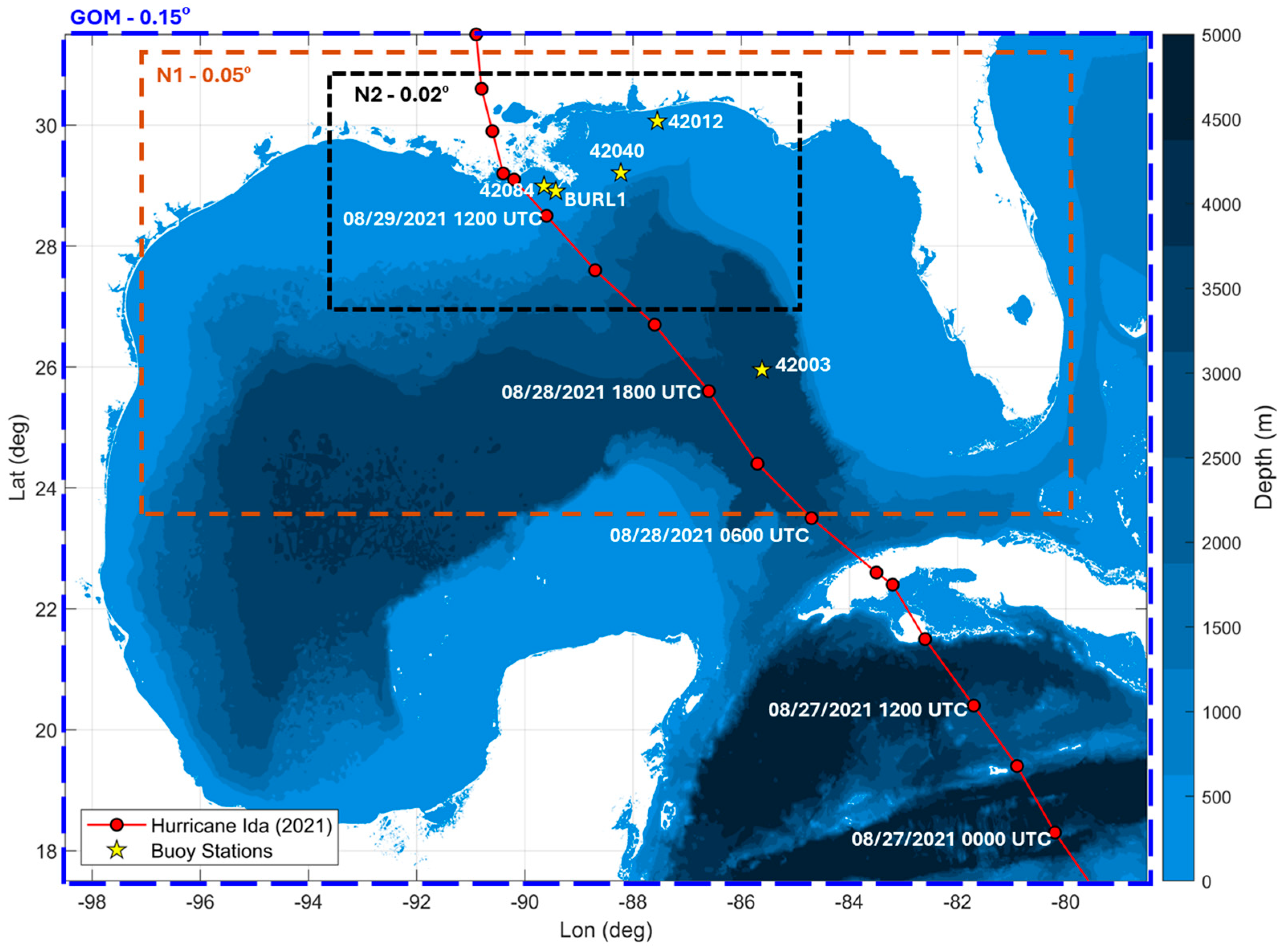
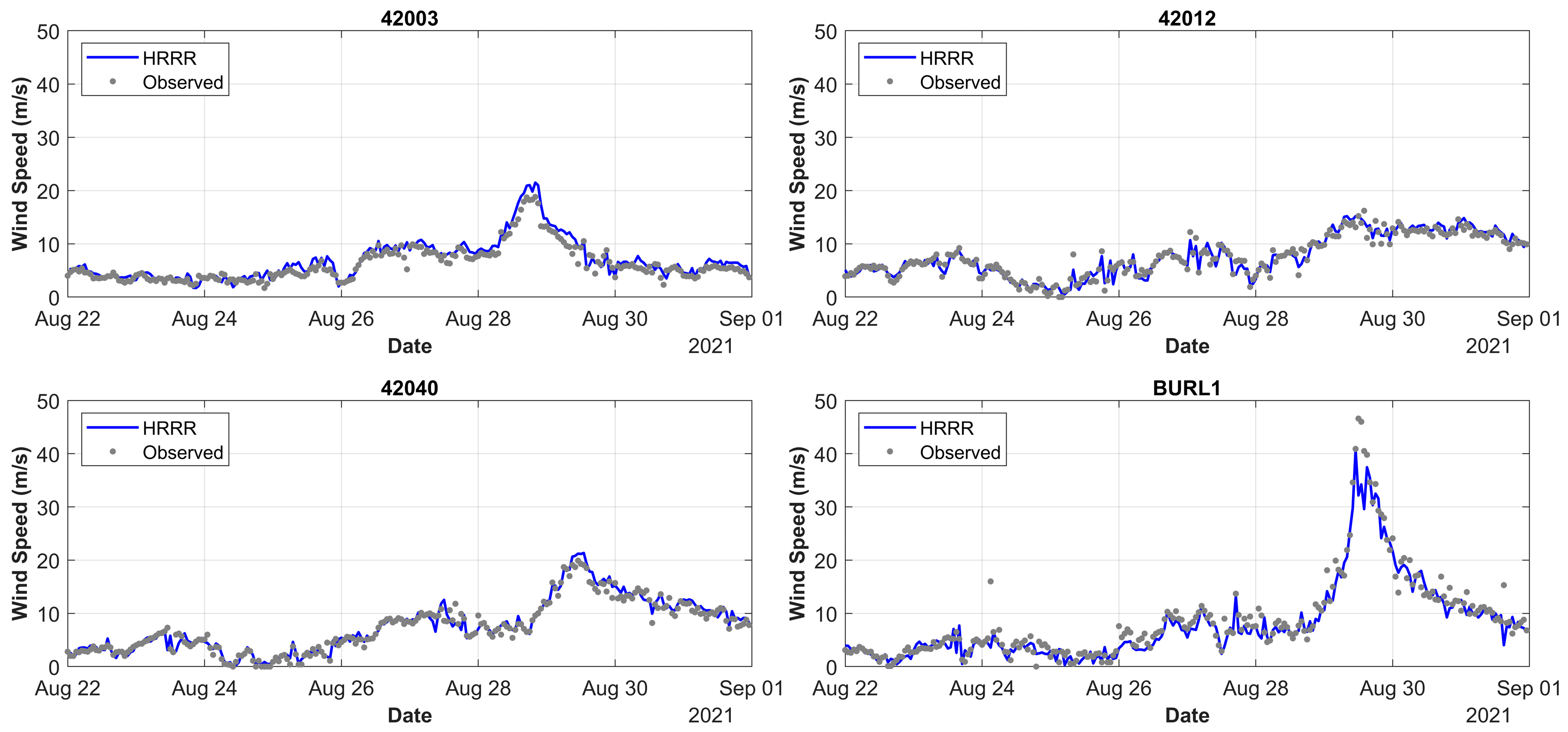
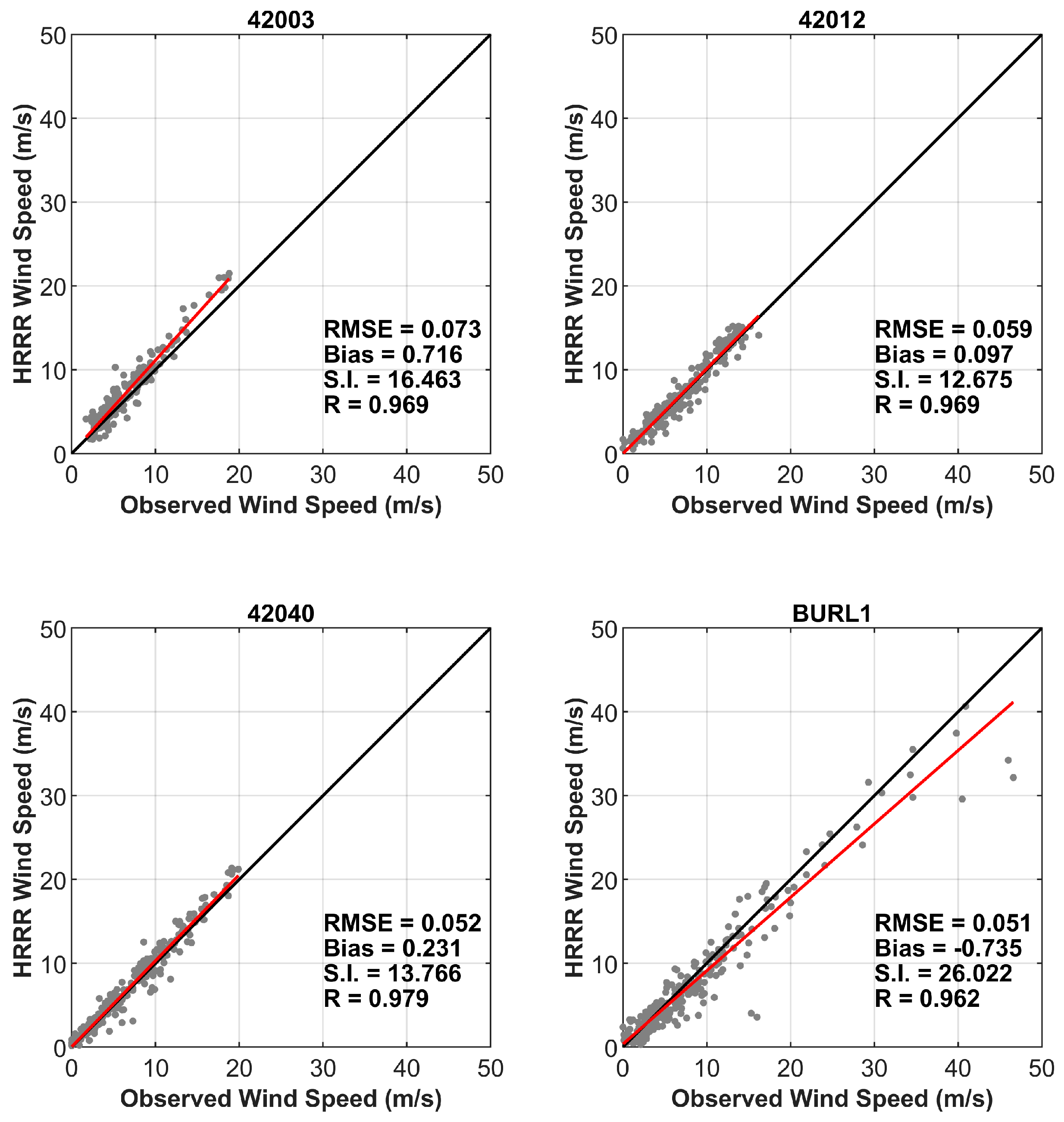
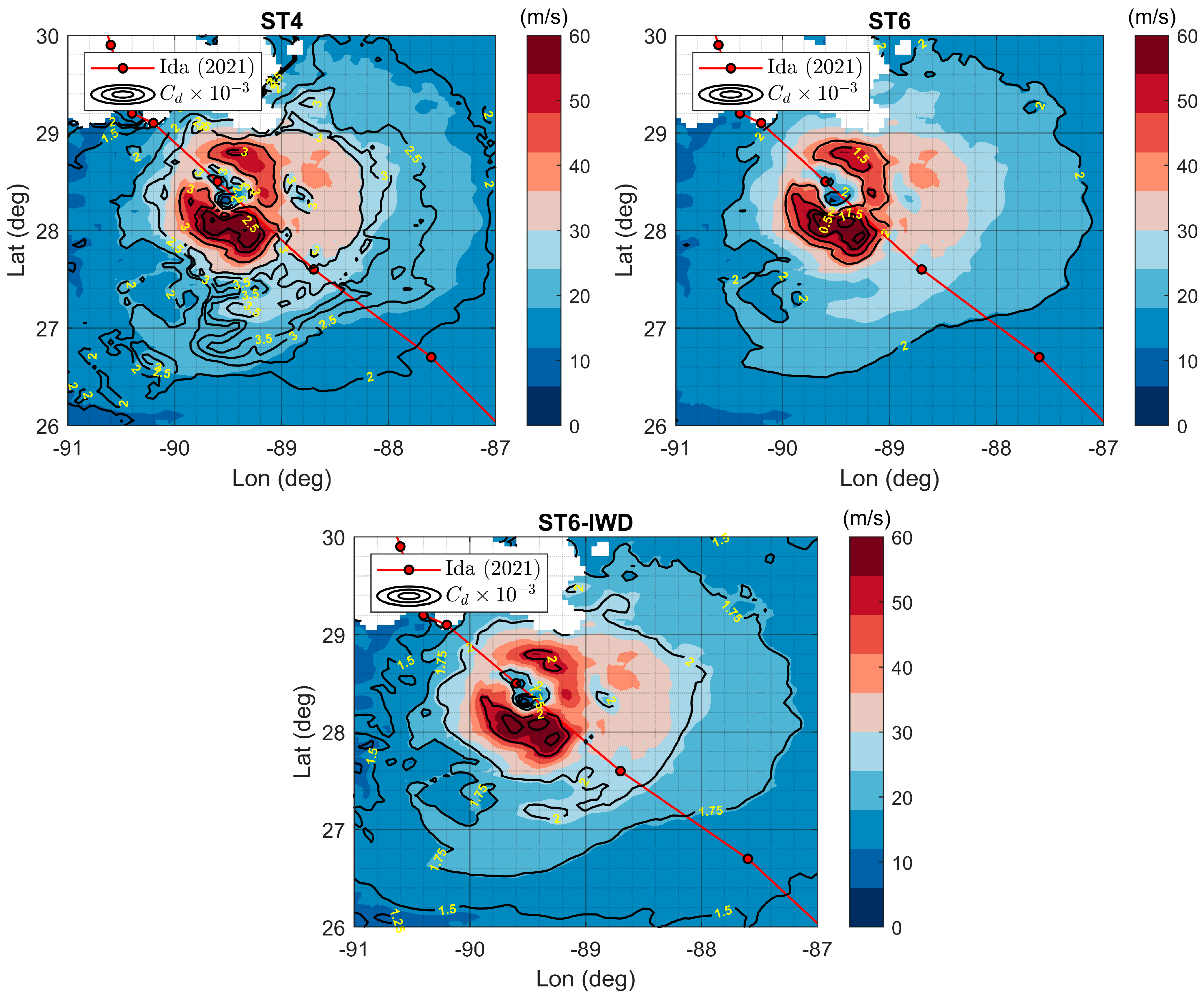
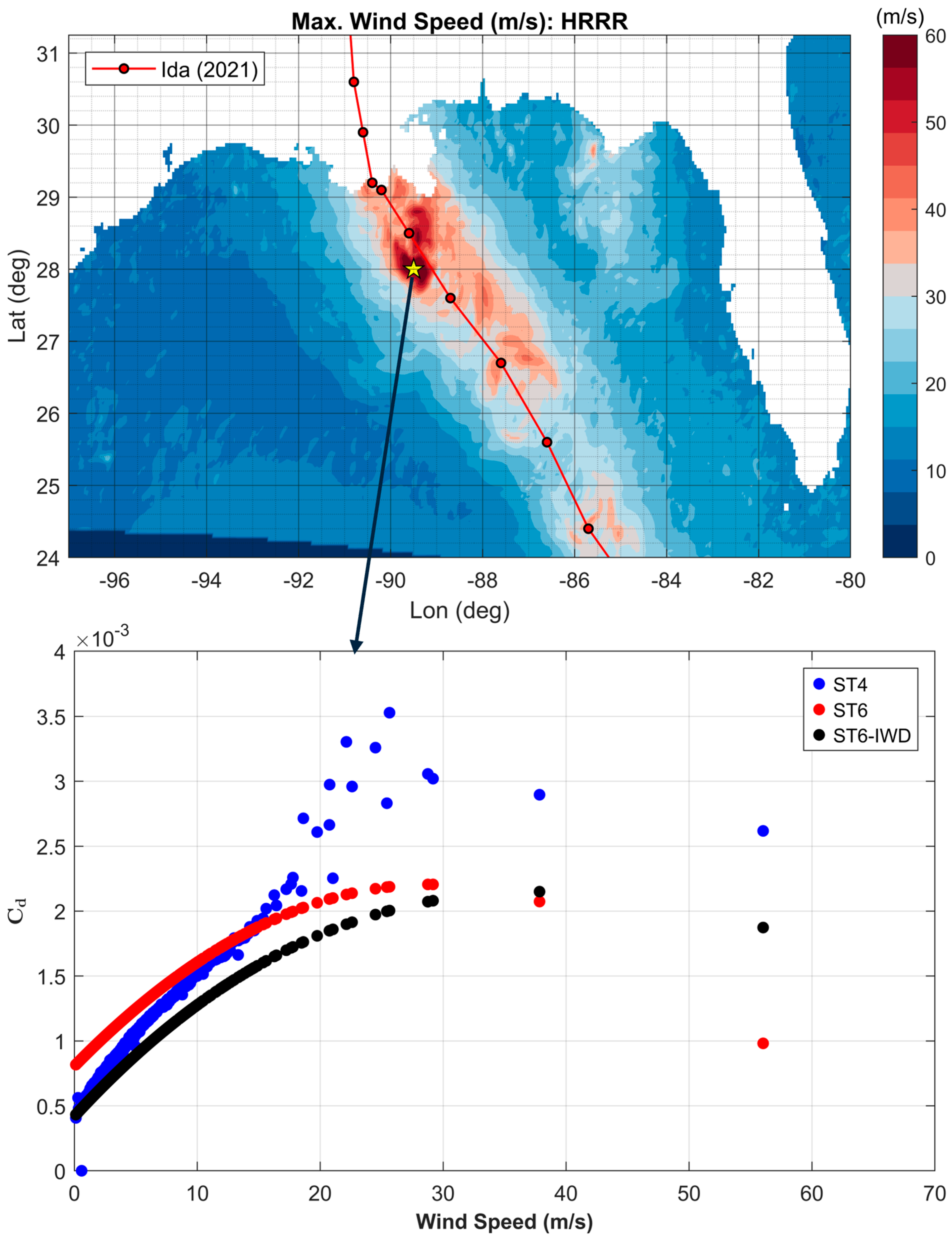
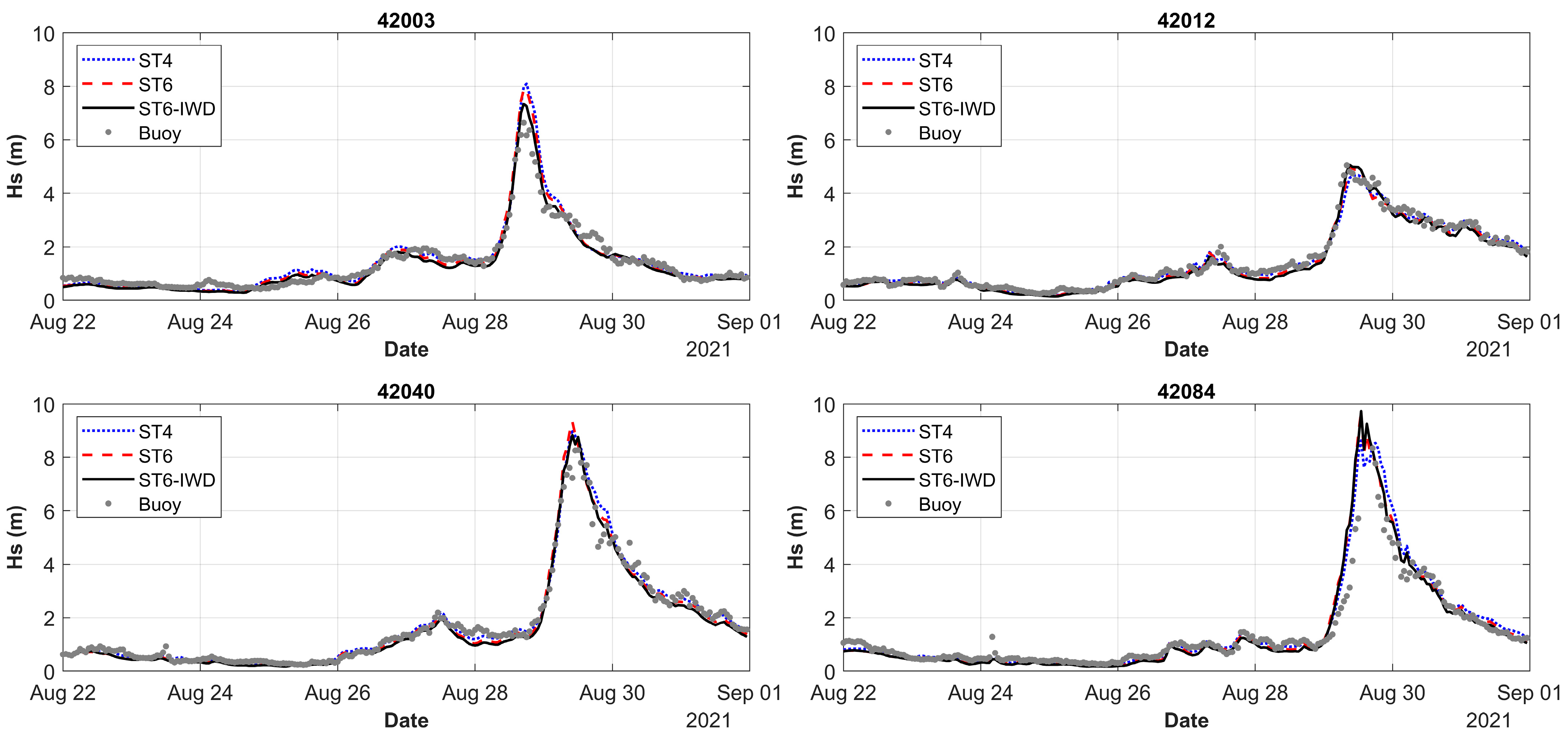
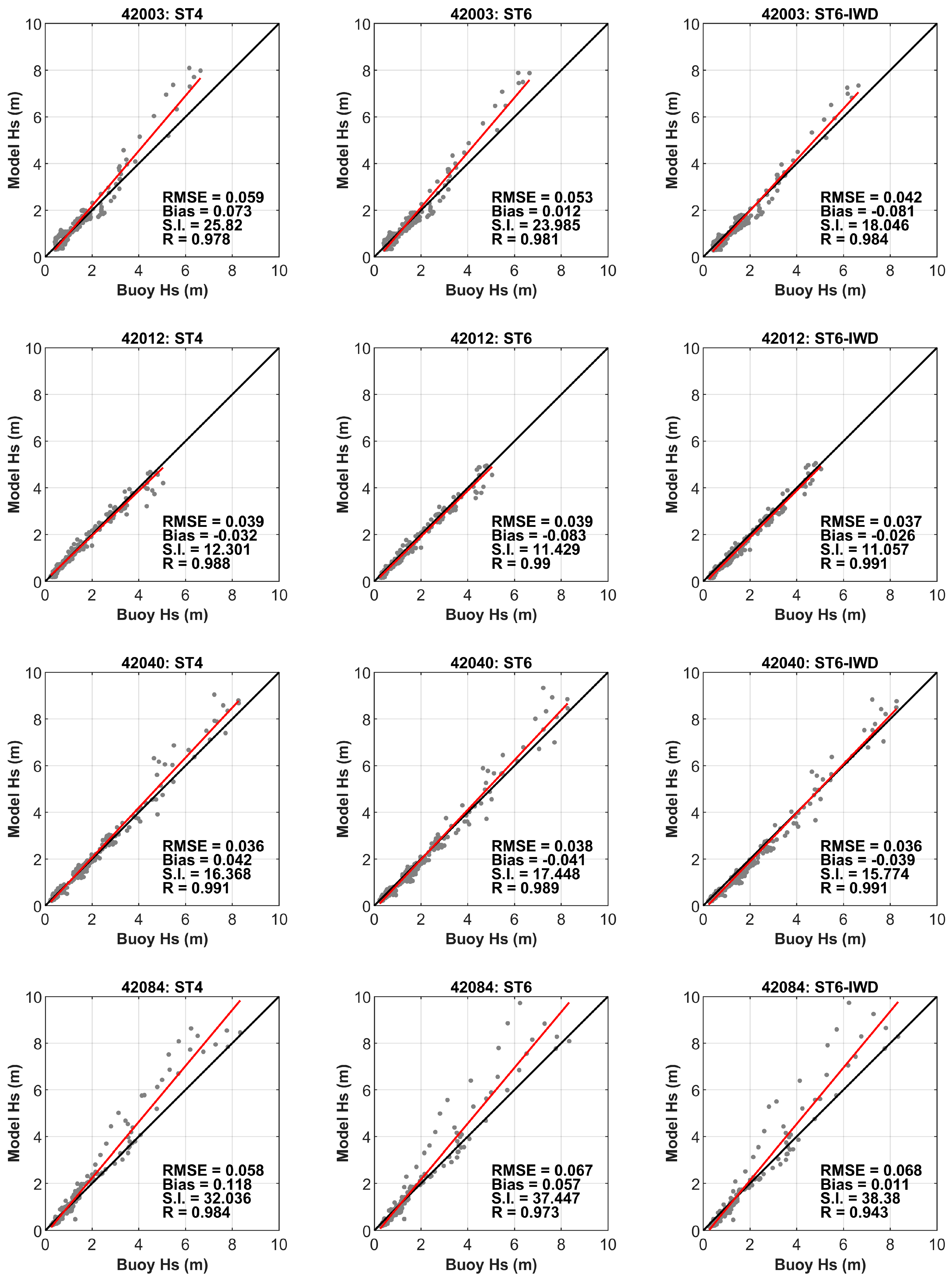
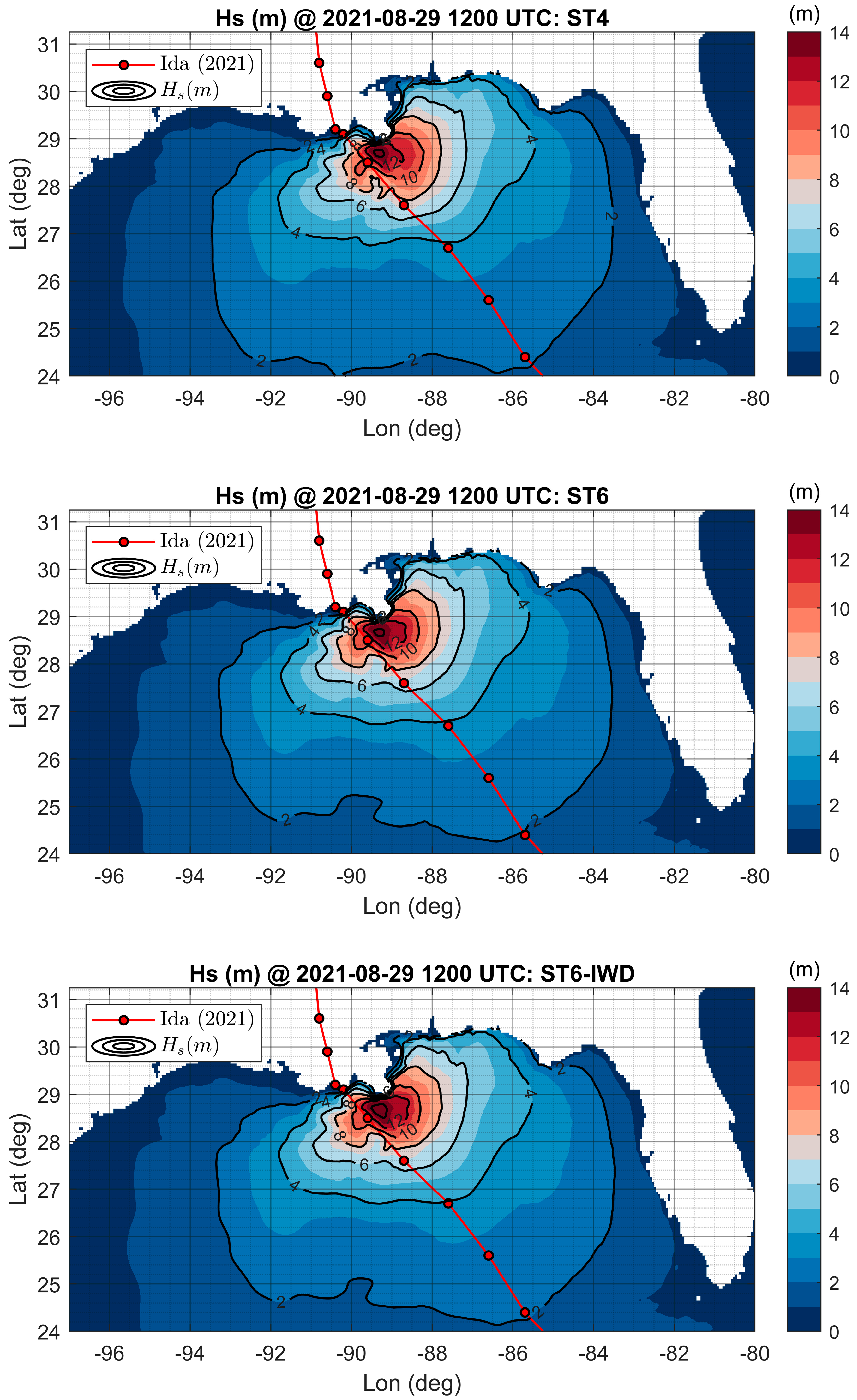
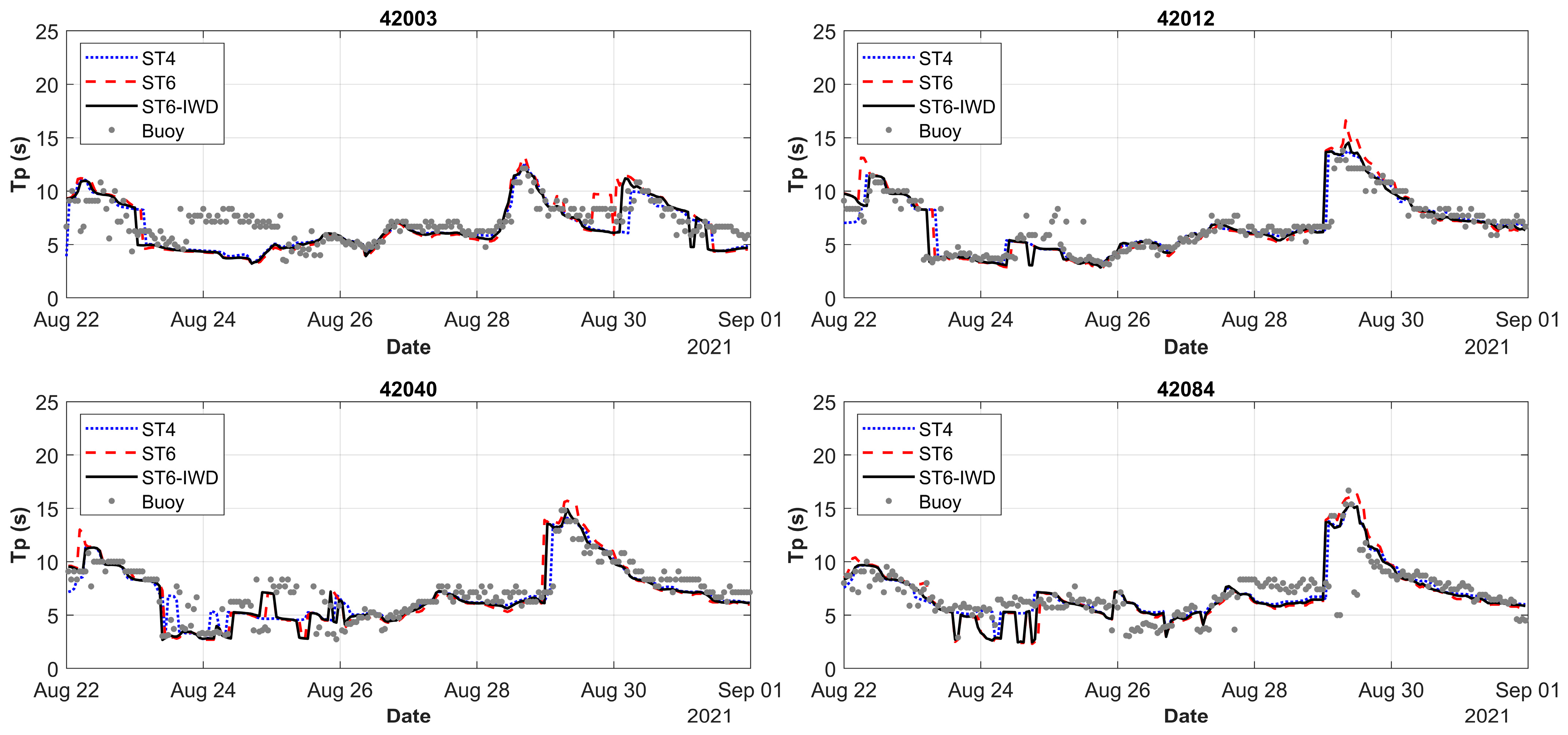
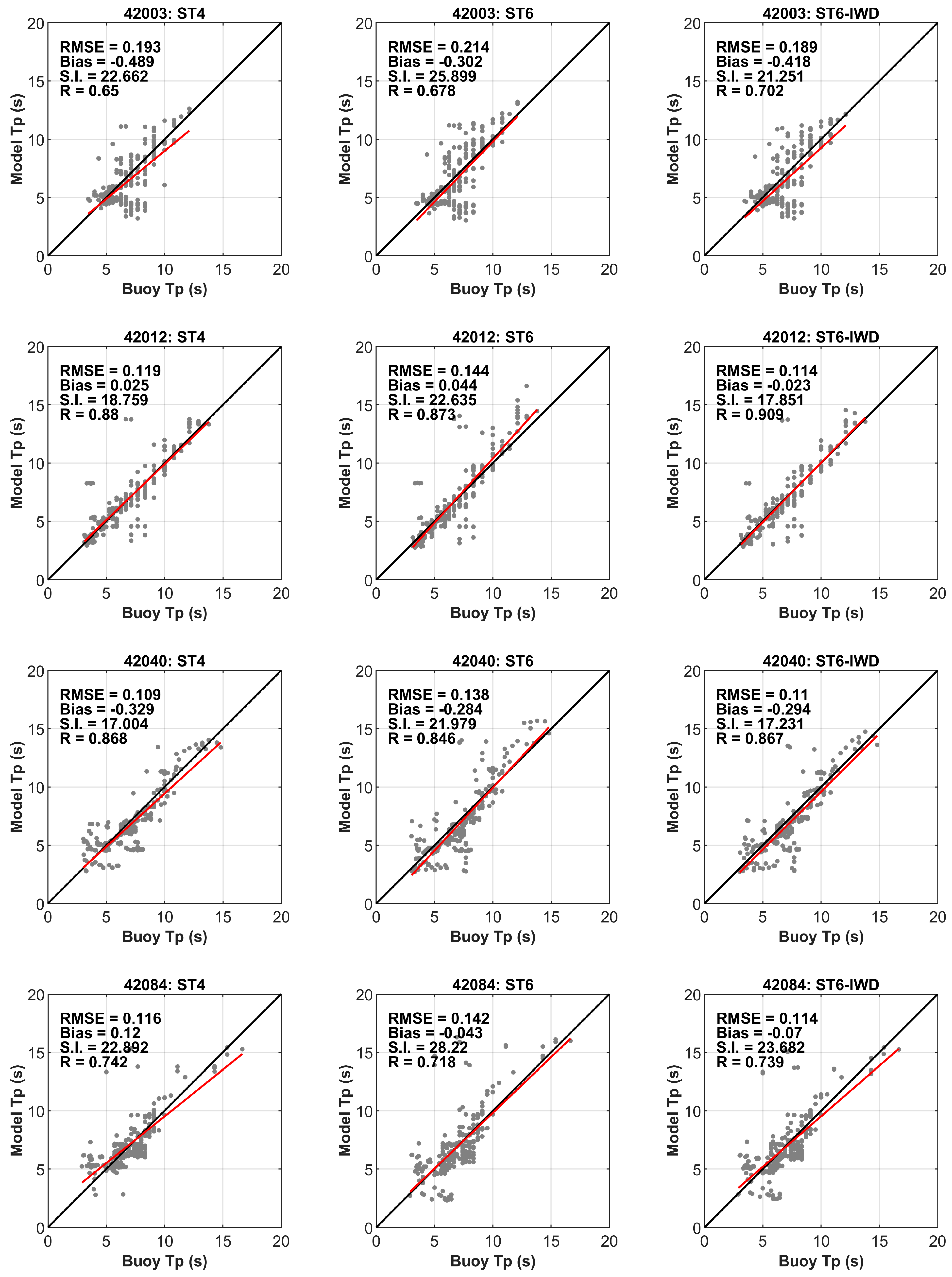
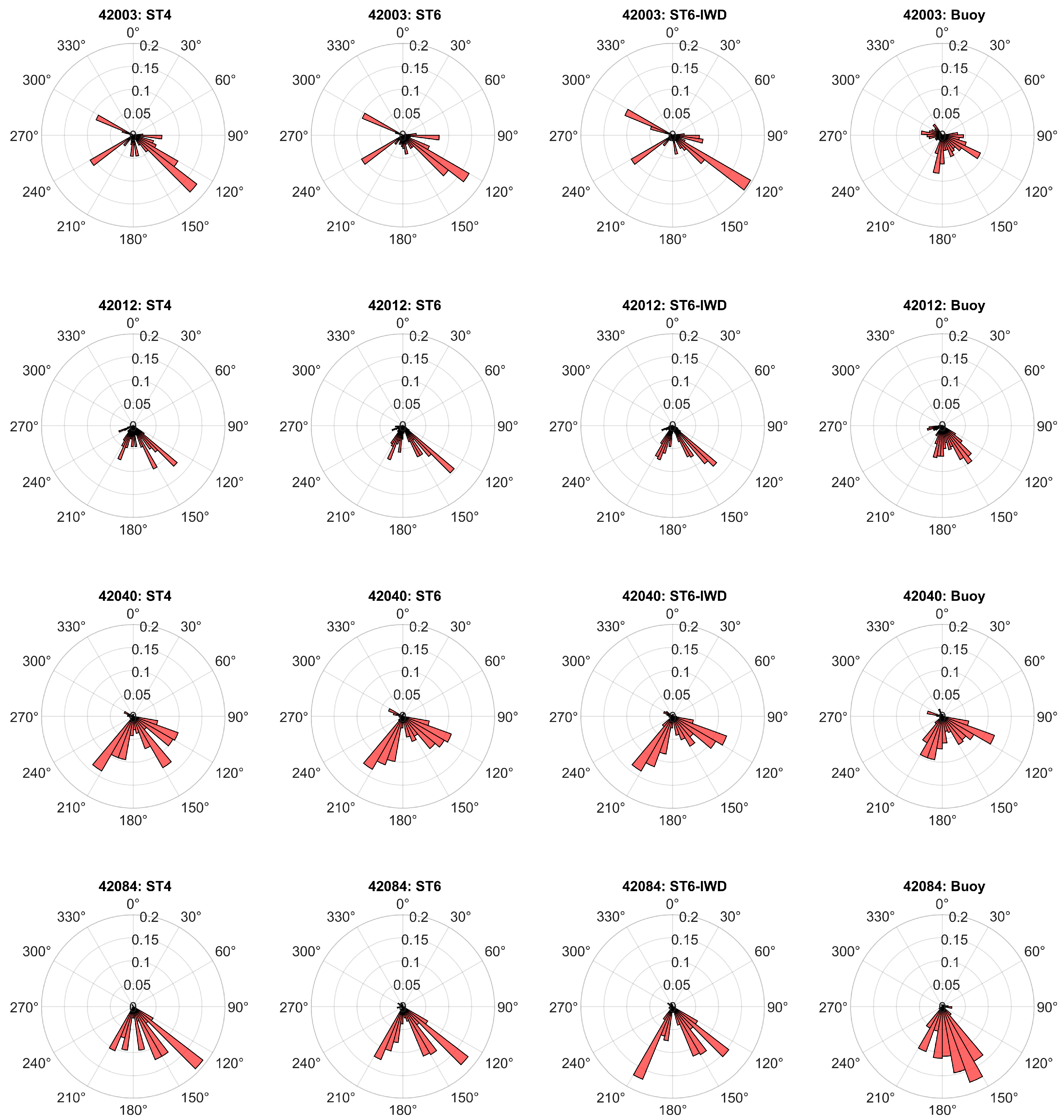
Disclaimer/Publisher’s Note: The statements, opinions and data contained in all publications are solely those of the individual author(s) and contributor(s) and not of MDPI and/or the editor(s). MDPI and/or the editor(s) disclaim responsibility for any injury to people or property resulting from any ideas, methods, instructions or products referred to in the content. |
© 2025 by the authors. Licensee MDPI, Basel, Switzerland. This article is an open access article distributed under the terms and conditions of the Creative Commons Attribution (CC BY) license (https://creativecommons.org/licenses/by/4.0/).
Share and Cite
Shankar, C.G.; Cambazoglu, M.K. Enhancing Storm Wave Predictions in the Gulf of Mexico: A Study on Wind Drag Parameterization in WAVEWATCH III. J. Mar. Sci. Eng. 2025, 13, 403. https://doi.org/10.3390/jmse13030403
Shankar CG, Cambazoglu MK. Enhancing Storm Wave Predictions in the Gulf of Mexico: A Study on Wind Drag Parameterization in WAVEWATCH III. Journal of Marine Science and Engineering. 2025; 13(3):403. https://doi.org/10.3390/jmse13030403
Chicago/Turabian StyleShankar, C. Gowri, and Mustafa Kemal Cambazoglu. 2025. "Enhancing Storm Wave Predictions in the Gulf of Mexico: A Study on Wind Drag Parameterization in WAVEWATCH III" Journal of Marine Science and Engineering 13, no. 3: 403. https://doi.org/10.3390/jmse13030403
APA StyleShankar, C. G., & Cambazoglu, M. K. (2025). Enhancing Storm Wave Predictions in the Gulf of Mexico: A Study on Wind Drag Parameterization in WAVEWATCH III. Journal of Marine Science and Engineering, 13(3), 403. https://doi.org/10.3390/jmse13030403





